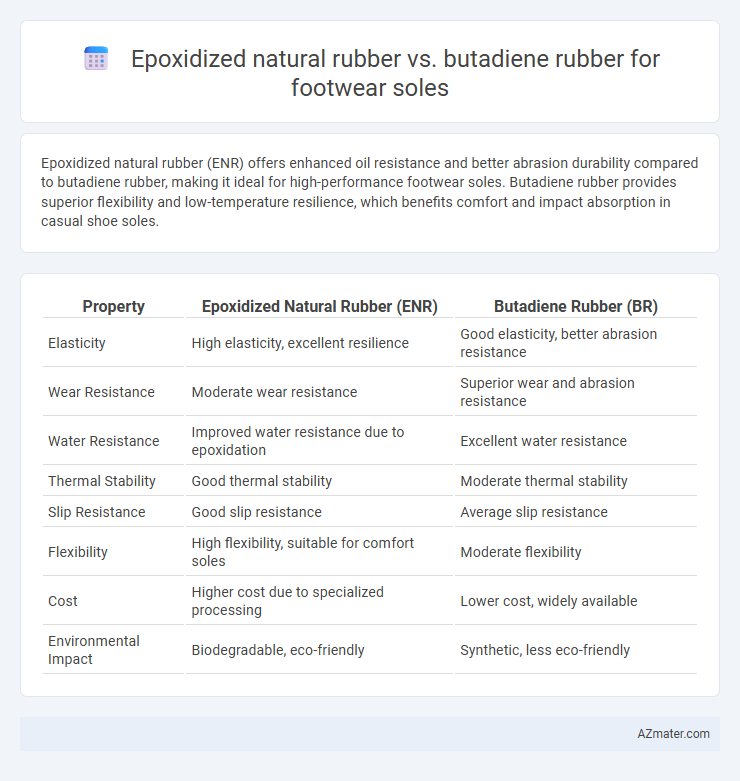Epoxidized natural rubber (ENR) offers enhanced oil resistance and better abrasion durability compared to butadiene rubber, making it ideal for high-performance footwear soles. Butadiene rubber provides superior flexibility and low-temperature resilience, which benefits comfort and impact absorption in casual shoe soles.
Table of Comparison
| Property | Epoxidized Natural Rubber (ENR) | Butadiene Rubber (BR) |
|---|---|---|
| Elasticity | High elasticity, excellent resilience | Good elasticity, better abrasion resistance |
| Wear Resistance | Moderate wear resistance | Superior wear and abrasion resistance |
| Water Resistance | Improved water resistance due to epoxidation | Excellent water resistance |
| Thermal Stability | Good thermal stability | Moderate thermal stability |
| Slip Resistance | Good slip resistance | Average slip resistance |
| Flexibility | High flexibility, suitable for comfort soles | Moderate flexibility |
| Cost | Higher cost due to specialized processing | Lower cost, widely available |
| Environmental Impact | Biodegradable, eco-friendly | Synthetic, less eco-friendly |
Introduction to Footwear Sole Materials
Epoxidized natural rubber (ENR) offers enhanced elasticity, abrasion resistance, and oil resistance due to its modified molecular structure compared to traditional natural rubber, making it a strong candidate for footwear soles. Butadiene rubber (BR) is widely used in footwear soles for its excellent wear resistance, low-temperature flexibility, and cost-effectiveness, especially in athletic and casual shoes. The choice between ENR and BR depends on specific performance requirements such as durability, flexibility, and environmental resistance in footwear sole applications.
Overview of Epoxidized Natural Rubber (ENR)
Epoxidized Natural Rubber (ENR) is a modified form of natural rubber where some of the double bonds in the polymer chain are converted to epoxy groups, enhancing its oil resistance, abrasion resistance, and gas permeability. ENR offers improved mechanical properties and better compatibility with other polymers compared to natural rubber, making it a superior choice for footwear soles requiring durability and flexibility. Its enhanced thermal stability and resistance to environmental factors make ENR a preferred material over butadiene rubber in applications demanding long-lasting performance and comfort.
Key Properties of Butadiene Rubber (BR)
Butadiene rubber (BR) offers excellent abrasion resistance and low-temperature flexibility, making it ideal for durable and resilient footwear soles. Its high tensile strength and good resilience contribute to enhanced comfort and long-lasting performance under diverse conditions. Compared to epoxidized natural rubber, BR provides superior wear resistance and aging stability, essential for high-traffic footwear applications.
Mechanical Performance: ENR vs. BR
Epoxidized Natural Rubber (ENR) exhibits superior abrasion resistance and enhanced tensile strength compared to Butadiene Rubber (BR), making it highly suitable for durable footwear soles. ENR offers better resilience and improved elasticity under mechanical stress, contributing to longer-lasting flexibility and shock absorption. In contrast, BR provides excellent wear resistance but tends to have lower grip and flexibility, affecting overall sole performance in demanding conditions.
Abrasion Resistance in Footwear Soles
Epoxidized natural rubber (ENR) offers superior abrasion resistance compared to butadiene rubber in footwear soles due to its enhanced polarity and cross-linking density, which improve its wear durability. Butadiene rubber, while flexible and cost-effective, tends to exhibit higher abrasion loss under prolonged friction, reducing sole longevity. ENR's enhanced resistance to scuffing and wear makes it a preferred material for high-performance footwear soles needing extended durability.
Flexibility and Comfort Comparison
Epoxidized natural rubber (ENR) offers enhanced flexibility and superior elasticity compared to butadiene rubber, making it an excellent choice for footwear soles requiring dynamic movement and cushioning. ENR's improved strain recovery and resistance to heat aging contribute to sustained comfort during prolonged wear, while butadiene rubber provides higher abrasion resistance but tends to be stiffer and less adaptable to foot contours. The incorporation of epoxide groups in ENR enhances interaction with fillers, resulting in soles that balance softness and durability, thus optimizing wearer comfort beyond that achievable with conventional butadiene rubber.
Environmental Impact and Sustainability
Epoxidized natural rubber (ENR) offers superior biodegradability and a lower carbon footprint compared to butadiene rubber, which is petrochemical-based and less environmentally friendly. ENR is derived from renewable resources, enhancing sustainability in footwear soles by reducing dependency on fossil fuels and improving end-of-life compostability. Butadiene rubber's production involves higher greenhouse gas emissions and generates non-biodegradable waste, making ENR a preferable option for eco-conscious footwear manufacturing.
Cost Considerations for Manufacturers
Epoxidized natural rubber (ENR) typically incurs higher raw material costs compared to butadiene rubber (BR) due to its specialized chemical modification process, impacting overall production expenses for footwear sole manufacturers. Although ENR offers superior abrasion resistance and flexibility, the increased cost can affect pricing strategies and profit margins in competitive markets. In contrast, BR remains a cost-effective choice with consistent availability, making it attractive for large-scale manufacturing where budget constraints are critical.
Applications in Footwear Industry
Epoxidized natural rubber (ENR) offers superior oil and abrasion resistance compared to butadiene rubber (BR), making it ideal for durable and flexible footwear soles in industrial and outdoor applications. ENR's enhanced resilience and grip improve comfort and safety in work boots and athletic shoes. Butadiene rubber, valued for its excellent wear resistance and low-temperature flexibility, remains prevalent in running shoes and casual footwear, balancing durability and cushioning.
Conclusion: Optimal Rubber Choice for Soles
Epoxidized natural rubber (ENR) offers superior abrasion resistance and enhanced oil and chemical resistance compared to traditional butadiene rubber, making it ideal for durable footwear soles in demanding environments. Butadiene rubber provides excellent flexibility and low-temperature performance, suitable for casual or athletic footwear requiring enhanced comfort and shock absorption. The optimal rubber choice hinges on application-specific requirements, with ENR favored for rugged, long-lasting soles and butadiene rubber preferred for lightweight, flexible footwear designs.

Infographic: Epoxidized natural rubber vs Butadiene rubber for Footwear sole
 azmater.com
azmater.com